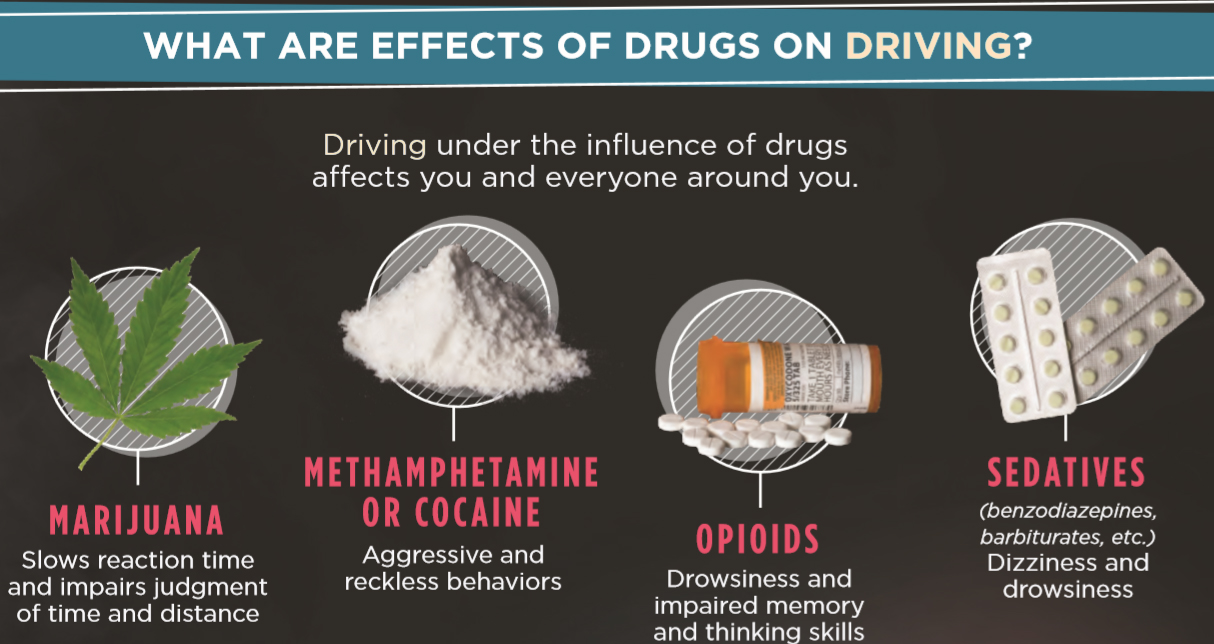29 Impaired Driving
emforde
Driving Under the Influence of Alcohol (DUI/DWI)
Drunk driving is an incredibly risky behavior that involves operating a vehicle when excessive amounts of alcohol are in the blood stream which can negatively impact driving skills. Once a person consumes enough alcohol for their Blood Alcohol Concentration or BAC to surpass the legal limit of 0.08, they begin to experience side effects such as fatigue, dizziness, poor decision making, and inability to focus(15). As one’s BAC increases, so does their ability to complete basic functions such as walking or talking. At a BAC of 0.02, a person may experience relaxation, a fuzzy mood and divided attention, hindering ability to multitask(15). At a BAC of 0.08, a person can expect to experience slightly impaired balance and speech and a decrease in concentration(15). Once a driver surpasses the legal limit of a BAC 0.08 and under, their driving becomes severely impaired. Reaction time slows down and a driver may no longer be able to maintain their own lane(15). A raised BAC over 0.1 is when most accidents occur as drivers no longer have full control of their vehicle(15).
In 2022, 31% of all motor vehicle accidents with fatalities involved drivers under the influence. Drinking and driving increases the risk of crash exponentially due to decreased motor skills, attention deficit, as well as lack of awareness of the road and world around you(15). College students aged 21-24 were at the highest risk for driving under the influence at 27% of DUI crash fatalities involving people in this age bracket(15). In this age group, men drive under the influence at much higher rates with 81% of drunk drivers being men and only 19% female(15). The rate of driving under the influence has steadily been increasing with a 35.5% increase of drivers admitting they drove when they believed they were over the legal limit of 0.08 BAC(15).
Besides the obvious consequences of bodily harm to the driver and others on the road, drunk driving has many other negative effects associated with it. One of the other consequences is high insurance rates. Once you have a DUI on your record, insurance companies label you as a “high risk” driver. Due to the increased risk a driver with a DUI poses; insurance companies will raise the premium to account for said risk(15). Insurance premiums from companies such as state farm can range from 1300-1500 dollars for a driver with no history of drunk driving and a clean record, but once a driver has been identified as high risk, the premiums can skyrocket to over 3000 dollars(15). In Iowa, you can be sure your car insurance rate will rise of 60% after a DUI conviction(16). Another consequence of drunk driving is the legal impact it may have. Laws vary by state, but often a DUI arrest can lead to license suspension and hefty fines. If it is your first DUI, an interlock system may be placed into the vehicle requiring you to take a breathalyzer prior to driving(15). If you do not take the breathalyzer or it detects alcohol in your system, the car will not start. The legal impact significantly increases once there is injury and fatality involved with another party. Injury may result in jail times ranging from 1-20 years(15). Vehicular homicide, particularly if the driver is determined to be under the influence, is a Class B felony charge and carries a hefty sentence of up to 25 years in prison(15).
Drugged Driving
Another issue affecting the safety of drivers on the road is a newly coined term called “drugged driving”. Drugged driving is when a driver operates a motor vehicle under the influence of a substance that can impair their driving(18). Even legal prescriptions can cause someone to drive more erratically than if they were to drive soberly(18). Drugged driving is a new phenomenon that is being talked about in the era of legalization of drugs such as Marijuana. It is reported that 1 in 4 drivers tested positive for one or more drugs that could impact their driving ability on the roads (17). Drugs such as benzodiazepines can severely slow reaction time as well as cause intense fatigue (18). One of the most common drugs people take and still operate a motor vehicle is Marijuana. Marijuana can cause effects like slowed reaction time, decrease of driver coordination, and impaired judgement of distance (18). Judgement of distance is incredibly important when it comes to driving as it allows the brain to tell us when we should begin to stop either at stoplights or during an emergency. There is still no roadside test to detect drugs in the body like there is for alcohol which is a challenge facing law enforcement officers, but many times those who use drugs and drive also drive under the influence of alcohol(18).

Effects of various substances on driving ability and safety
Photo Credit: Get Smart About Drugs Campaign
